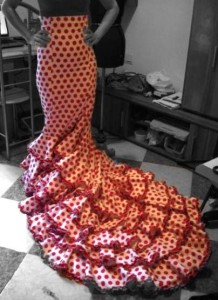 Most people are fascinated when seeing a flamenco dancer in a bata de cola on stage. If you have ever wondered what a bata de cola looks like from the inside or even thought of making one yourself the following overview might help.
Most people are fascinated when seeing a flamenco dancer in a bata de cola on stage. If you have ever wondered what a bata de cola looks like from the inside or even thought of making one yourself the following overview might help.
A bata de cola can be a skirt or a dress. A skirt is more practical for classes and rehearsals, both skirt and dress look great on stage. I will concentrate on the skirt part since it is there where the bata de cola differs from other flamenco outfits.
The skirt consists of 6 panels with the back part ending in a “cola” i.e. tail. Pattern pieces look something like this: 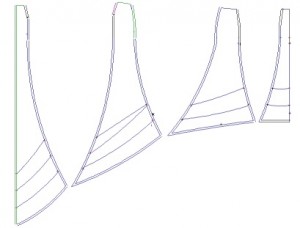 .The “cola” can be longer or shorter but most often the length of the back seam, from waist to the end of the “cola”, will be a somewhat more than the dancer’s height.
.The “cola” can be longer or shorter but most often the length of the back seam, from waist to the end of the “cola”, will be a somewhat more than the dancer’s height.
Looks aren’t everything; a bata de cola needs to be fit for dancing. To make sure it allows for the required movements and doesn’t flip over a few points need to be taken into consideration:
- Material A bata de cola is generally fully lined, right to the “tip of the tail” in order to achieve the necessary
stiffness and weight. Fabric choice is up to you but keep in mind that a light weight outer fabric requires a heavier material for the lining, perhaps even two layers of lining. If the bata de cola doesn’t have enough “body” it will collapse and flip over while dancing. Check out Flamenco Fabrics – What to Buy for more tips on choosing fabric.
- Weight A bata de cola needs some weight. Without it it won’t move well. That said, there are very light weight bata de colas that work wonderfully for certain dances. One thing is certain, if it is too heavy it becomes difficult to manage. What exact weight is right is a matter of personal preference and also depends on the way dance. They key is to find the ideal balance between weight and body in order to manage the bata de cola the way you want.
- Cut The skirt must fit snugly around the hips. If it is too lose it is difficult to move the cola. How tight it should be below the hip depends on your dance technique. Some of my clients move the cola only with the lower part of the leg and therefore prefer the skirt tight, others need more space in order to dance comfortably. Trial and error is again the way to go. The same is true for length and shape of the cola but consider – the longer and bigger the cola the more difficult it is to move.
- Length I have already talked about the length of the cola. Another important point to look at is the length at the side. It needs to cover the shoe when you lift your leg out to the side. This is how you move the cola and if the skirt is too short at this point dancing will be more difficult. If it is too long though you might step on it (and there goes the elegance …)
- Ruffles How many and what kind of ruffles you have on the outside is up to you. Ruffles add volume and weight. When you are starting out dancing with a bata de cola you probably don’t want too many. An extra ruffle is often a solution when the bata de cola is a little too light or not stiff enough. When the bata de cola doesn’t have many ruffles the ruffles are made of two layers to give them some lift and add to the stiffness of the cola. For the same reason a bata de cola has ruffles, usually made from tulle or some other stiff material, on the underside
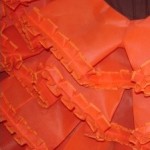 .
.
Every dancer is different and each one has to figure out what works best for her. It often takes some experimenting until everything is right. But it is worth the effort, don’t you think?
Ready to get started making your own?
If you’d love to have your own bata de cola but you’re not quite sure whether you can pull it off without help register for the upcoming FREE live video class to look “under the hood” of a bata de cola so you can make up your own mind about making one. You may find it’s not as hard as it may seem: “How to Make the Underside Ruffles for a Bata de Cola”
If you know what you’re doing the pattern is for you:

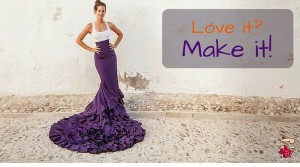





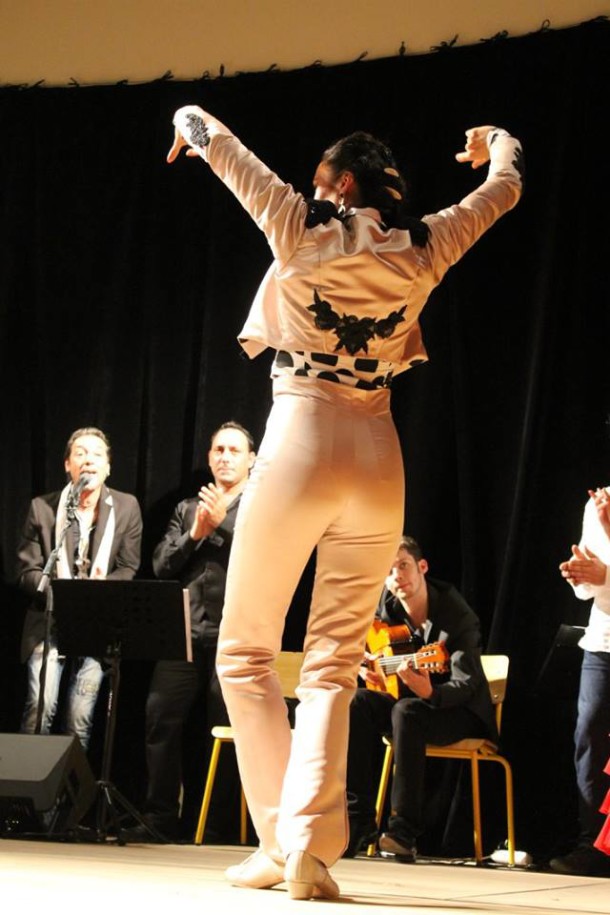
Hola,
Thank you so much for your postings, they are so helpful!! And your batas de cola are gorgeous…
I’ve been dancing flamenco for a while and now wants to experiment with the bata. I was wondering if you could give me a few tips on making my own ideal practice bata skirt. I’m not very tall (5’4″) and skinny so I need a light bata, but that’s still easy to move around.
My questions are mostly about the ruffles (your instructions on the train itself are very clear):
– Do you recommend 2 front / 4 back ruffles or 3 front/5 back ruffles for practice?
– Should these ruffles be lined?
– How many circular ruffles do you use to make the whole contour? 1 full circle ruffle per section (so 6 total) or is that too much gathering (should I use 3-4 instead)
– Are inside ruffles needed for practice skirt? If so how many? I have seen some with one ruffle at the tail end only, and others that have 1 front/3 back ruffles. What do you recommend?
Thank you so much for your help!!
– Do you recommend 2 front / 4 back ruffles or 3 front/5 back ruffles for practice?
This really is a matter of taste, both work so which ever you like more (see also answer to question 2)
– Should these ruffles be lined?
In short – for practice bata de colas I use a fairly heavy poplin type fabric and usually line 2 front/4 back ruffles. When I put 3 front/5 or 6 back ruffles I tend to leave them unlined (I have on occasion lined them but the bata does become rather heavy). Whether or not to line depends on how heavy the fabric is and whether it has body or not, also what the underside looks like. For example, if you use a light printed poplin type fabric for the ruffles you will probably want to line them. If you don’t the bata may not weigh enough to move well and the ruffles tend to flip over while dancing and the often not so pretty underside shows. Lining ruffles adds body and weight, so it is a good idea if you have few ruffles. If you want more ruffles and the fabric is not very light I’d go for unlined ruffles. If you need more weight or body it is easy enough to put another ruffle in between or above.
– How many circular ruffles do you use to make the whole contour? 1 full circle ruffle per section (so 6 total) or is that too much gathering (should I use 3-4 instead)
I’m not sure I understand the question 🙁 I always attach the ruffles to the finished skirt. I mark the position on the skirt and measure the number of meters I need. Then I cut the required number of circles (depending on the inner diameter), join them to form one long ruffle, finish the edges and attach them following the markings. In any case I’ll include a pattern for the ruffles and indicate on the pattern pieces an option of where they should go.
– Are inside ruffles needed for practice skirt? If so how many? I have seen some with one ruffle at the tail end only, and others that have 1 front/3 back ruffles. What do you recommend?
Definitely. The underside ruffles add body to the cola and ensure that it doesn’t flip over when dancing. For practice skirts I usually put 1 front/3 back ruffles. I’ve also had clients who wanted 2 in the back, others wanted 5 which makes the whole cola part pretty stiff. What you need depends on what and how you are dancing but for a practice skirt you can’t go wrong with 1 or two in front and 3 at the cola.
where can you buy the correct fabric for the under ruffles? Not easy to find something stiff enough with some color choices in the USA
The material used for the ruffles underneath is called “can can” over here. http://www.tejidosreytex.com as well as http://www.flamentex.es have an ample selection of colours available. Unfortunately, I don’t know of any suppliers in the US.
Hello,
Here in Brazil we have some similar fabrics to Cancan.
The most similar tissue is called ‘Nylon 40’, others are ‘Trilobal’ and ‘Helanca Light’.
All of these tissues are 100% polyamide without elasticity.